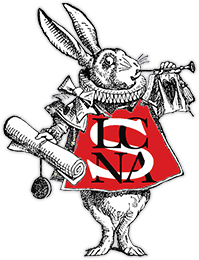The LCSNA’s very own Mark Burstein has written a concise list of “all those awful Alice movies” (a theme that many in the media have been attempting, as reported here) for Lucas Films’ Blockbusting blog. An excerpt:
- The groovy Sixties found a resurgence of interest in Carroll’s otherworld of mushrooms and hookah-smoking caterpillars. Hanna-Barbera’s Alice in Wonderland or What’s a Nice Kid Like You Doing in a Place Like This, voiced by Sammy Davis, Jr., Zsa Zsa Gabor, etc. was shown on television in 1966. Later that year, Alice Through the Looking Glass, a musical version with Jimmy Durante, The Smothers Brothers, etc., ran on television as well. Meanwhile, in Britain, the BBC produced a low-key, black-and-white Alice in Wonderland that is arguably the best, certainly the most faithful to the spirit, of all cinematic or televisual adaptations. It was directed by Jonathan Miller, and starred Sir John Gielgud, Peter Sellers, etc.
- The spirit of the Sixties lasted at least until 1972, when a lavish British musical version ofWonderland starring Fiona Fullerton (later a Bond girl) as Alice, and with Spike Milligan, Peter Sellers, Dudley Moore, and so on came to the big screen.
- A soft-core porno-slash-musical comedy Alice in Wonderland spewed forth in 1976, produced by Bill Osco, directed by Bud Townsend, and distributed by General National Enterprises. Ah, me. It’s very nearly watchable, but was the first of many subsequent erotic films “based” on the books, all of which lack even the marginal charm of this original one, and are not subject matter for this brief overview.
“If you go back to Tenniel, so much of his work is what stays in your mind about Alice and about Wonderland,” Burton said. “Alice and the characters have been done so many times and in so many ways. but Tenniel’s art really lasts there in your memory.”
Tenniel was already a major name in political cartooning (and, unfortunately, blinded in one eye from a fencing wound) when he took on the illustrations for Carroll’s strange fantasy. The job was a frustrating one due to the intense detail work and specifications that came from Carroll (whose real name, by the way, was Charles Lutwidge Dodgson), but Tenniel had a passion for drawing animals, and Wonderland gave him a singular opportunity for creatures of the fantastic. Tenniel was also a meticulous soul and a demanding artist — the first run of 2,000 copies of “Alice” in 1865, for instance, did not meet his standards and were pulled back. The project was well worth the trouble, however, when the book became an instant literary sensation.


